- Trusted by Over 2000 Schools Nationwide
- Top-Rated PD Provider ★★★★★ 4.77
- Save with our Kits & Packages – Shop Now! →
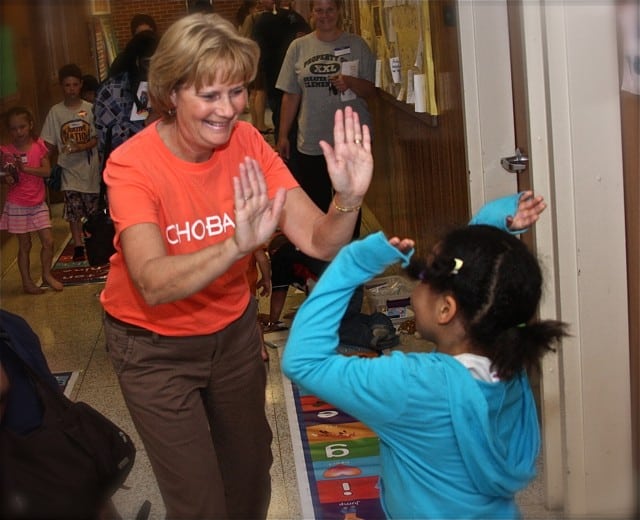
There are many interrelated problems to be addressed in education. A short summary includes:
We propose that a Math & Movement symposium followed by ongoing implementation of the Math & Movement program will helps schools quickly and effectively address all of the concerns described above.
Math & Movement a kinesthetic, multi-sensory approach to teaching math that incorporates physical exercise, stretching, cross-body movements, yoga, and visually pleasing floor mats designed to encourage students to practice math concepts. The purpose of Math & Movement is to utilize physical activity to enhance reading and mathematics skills in elementary grades pre-K through 5th grade, to meet the mastery learning expectations of Common Core, to reduce RTI costs, to increase student engagement, to integrate math practice throughout the day, to increase students’ 2 ability to focus, to offer differentiated instruction, to support equity, to boost self-confidence in students, to reach kinesthetic learners, and to speed learning of math facts.
Additionally, Math & Movement increases physical education (PE) minutes, improves physical fitness, and combats obesity. The bright colors and large numbers on mats and banners make learning math effective and enjoyable for children, thus decreasing frustration levels. Adding the Math & Movement program to an existing curriculum allows students to physically hop, walk, crawl, dance, or touch the patterns as they learn, using more learning modalities (visual, auditory, motor and kinesthetic) when practicing.
A Math & Movement symposium is a two-day event led by Suzy Koontz, the creator of the Math & Movement program. A symposium is hosted by one or more school districts and is located on a school campus during regular school hours (with an evening family engagement event). It primarily consists of demonstrations and interactive activities to train teachers how to implement the exercises/techniques of the Math & Movement program. Teachers receive training, then immediately practice their new skills with students from the host school. They then receive feedback and suggestions from Suzy Koontz. The first day of the symposium concludes with a Family Fun Night, a family engagement event that uses the M&M materials and provides teachers another opportunity to practice their new skills. During the Family Fun Night, parents and children move from station to station, learning the math activities while completing a Math & Movement activity guide. Older students, who volunteer to assist teachers at the stations, improve their own math skills through helping younger students. Parents and children have fun learning together.
The students worked one-on-one with teachers for approximately 90 minutes over two days. On the pre-test, many of the second grade students did not know any of the multiplication by 3’s problems. On the post-tests, 56% of the students had nearly all 32 multiplication facts by 3’s answered correctly and ALL the students demonstrated a large increase in number of problems solved. Both the pre- and post-test were completed without the use of any floor mats or banners. The following chart shows the results of the pre-test and post-test, along with an assigned level of educational ability given by the classroom teacher. Please note that regardless of said level, Math & Movement techniques were successful with all students.
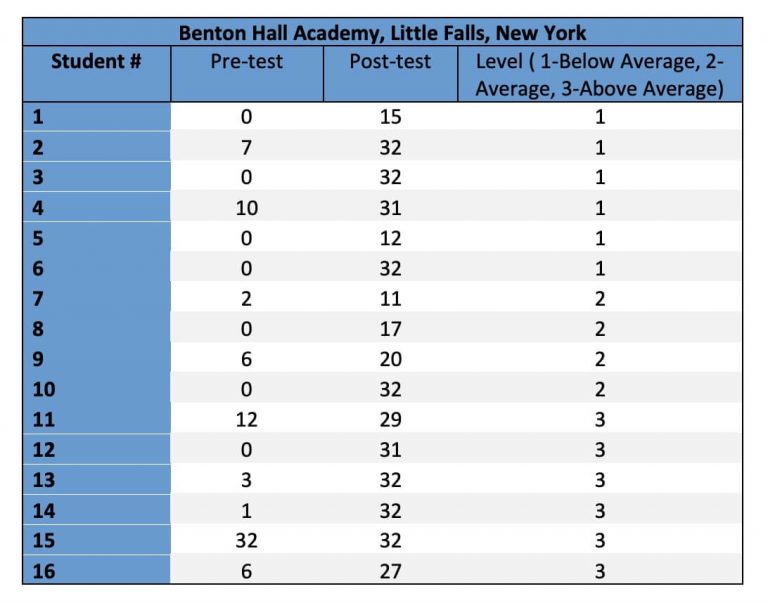
The teachers observed that Math & Movement allowed the students to increase their focus and determination in completing the math problems. Many teachers commented about their student’s transformation from indifference to enthusiasm towards math practice. They noticed an increase in student self-confidence. The teachers commented that the students learned how to use the floor mats as a tool to consistently determine the correct answer.
At this symposium, third grade students worked with teachers for four sessions over a two-day period. The data shows the number of problems answered correctly on the preand post-tests. The pre-and post-tests were identical and contained 32 multiplication problems focusing on only one multiplication fact. In both tests, students had one minute to solve as many problems as they could.
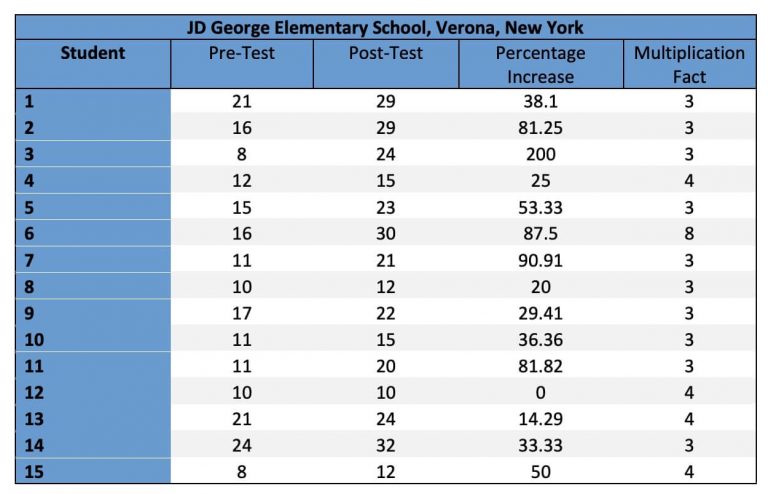
Upon averaging the column labeled ‘percentage increase’, it was found that these students had an overall rise in their understanding of this topic by 56%. This is a massive increase in just a very short time span and shows the success these kinesthetic movements can have on the adolescent brain and memory.
At this symposium, third grade students worked with teachers for four sessions over a two-day period. The data shows the number of problems answered correctly on the preand post-tests. The pre-and post-tests were identical and contained 32 multiplication problems focusing on only one multiplication fact. In both tests, students had one minute to solve as many problems as they could.
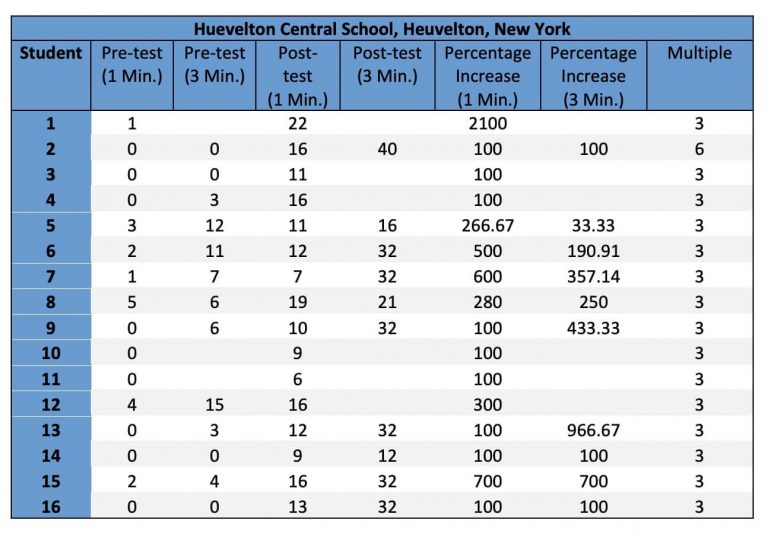
During these trials, students were tested after both one minute of activity and after three minutes of activity to show prolonged results and how more physical activity, while simultaneously practicing their multiples, can bring positive results. All students in this trial demonstrated a large increase in problems solved in both the one minute and three minute post-tests.
The same trials were run with these students as the previous two data charts. The results speak for themselves as there was an average increase of 90% in regard to their multiplication fact completion, based upon their given multiple.
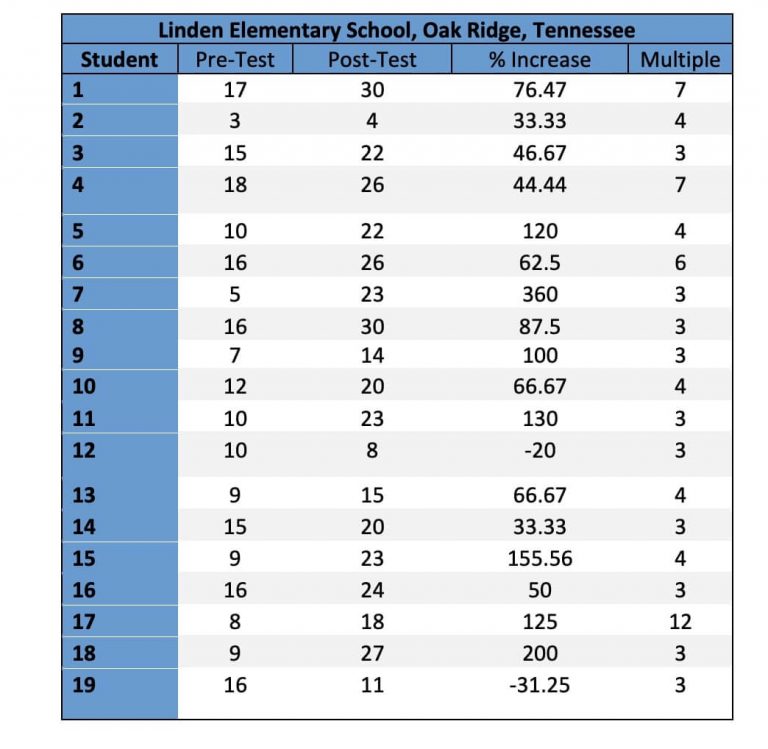
Almost all teachers who attended these symposiums found them to be insightful, entertaining, and informative about the Math & Movement program. Below are comments made by said teachers and what they thought of the event:
“The level of focus displayed while engaging in Math & Movement during the Symposium has rarely been exhibited in the classroom.” “Math & Movement allowed the students to increase their focus and determination in completing the math problems.”
“I noticed an increase in student self-confidence from my students.”
The teachers also all agreed that the students at the symposium learned how to use the floor mats as a tool to consistently determine the correct answer. All of these responses indicate that the program is a success and can help any child improve their learning abilities and thinking skills. Teachers have highly recommended both the symposium and Family Fun Nights to help educators learn what they could be doing in their classrooms to make learning easier and fun.
Teachers who have attended other Math & Movement trainings programs (such as the National Math Foundation’s Summer Institute) have provided additional feedback on not just their students’ success, but their own enthusiasm about using M&M in their classroom. A small sampling of that feedback follows:
“The workshops presented during this institute were truly amazing and left me feeling so inspired. I’m going to be aggressive about getting these mats for my classroom. This program is essential for children. Thank you!!”
“As a first year teacher, you exceeded my expectations and provided me confidence in my ability to help my students learn math. My goal as a teacher was to make learning fun and this workshop has given me the tools to meet this goal.”
“Thank you for helping me grow my passion for teaching again! I felt like my time and teaching was in vain sometimes. You gave me something to be excited about again.”
Math & Movement recognizes the importance of engaging families* in their children’s education. We believe the learning process should span from home to school to community. Parents are an important part in helping to reinforce the lessons learned from Math & Movement and the kinesthetic movements a child is taught in school can easily be done at home. At a Family Fun Night, parents are shown how to be engaged with all of the activities and are also provided resources to continue the learning with their children at home. Parents and children respond very positively to this and, when fostered by the school, this process can bloom into a stronger relationship with the school and ongoing family engagement. This program is perfect for students and their close relatives to educate them on our company and what we can offer to them and their community.
*Please note that when we refer to families, we are also including legal guardians and other members of a child’s personal support network.
A symposium is a great first step in helping any school improve their math test scores, improve student physical fitness, re-ignite teacher enthusiasm, and initiate new relationships with families, using an easy-to-implement kinesthetic learning program such as Math & Movement. The symposium and associated Family Fun Night give immediate benefits to students, teachers, and families. Additionally, the training teachers receive is essential for their students’ ongoing success. Families benefit from the training and resources and develop positive feelings toward the school and its staff. Teachers regain/renew their enthusiasm for teaching and become committed to ongoing active engagement with their students. While the short-term benefits of a symposium are astounding and reason enough to implement this model, all of these benefits are amplified when the Math & Movement program is implemented in the classrooms following the symposium.
Movement isn't just for recess
Want to get started with movement-based learning right now? Enter your email to get our training manual with over 250 active math movements. No materials necessary!
Subscribe to Our Newsletter
We never share or sell your data.
Please leave your email and a quick note for us. We will get back to you soon! In the meantime, here are answers to some of our most common questions:
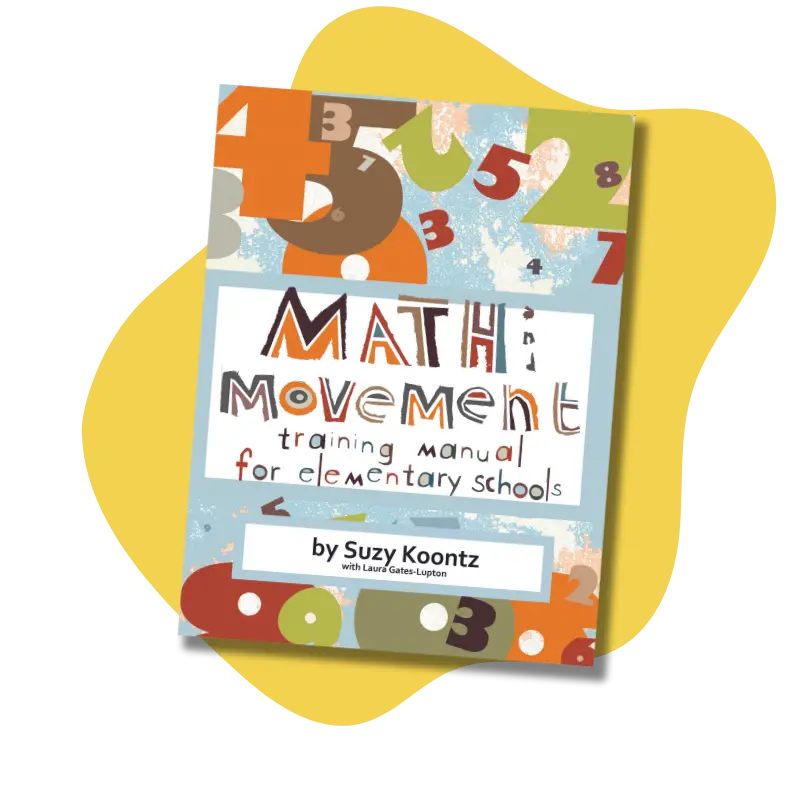
Enter your email to get our training manual with over 250 active math movements. No materials necessary!
We never share or sell your data.